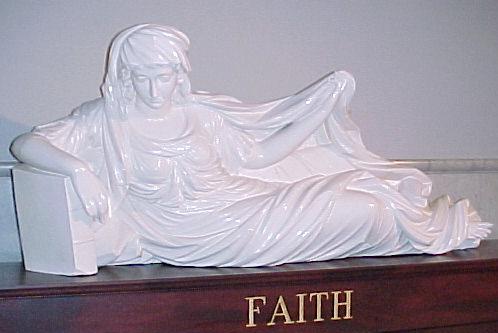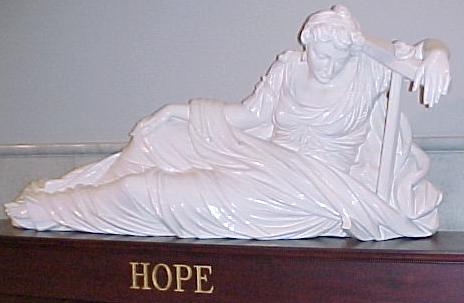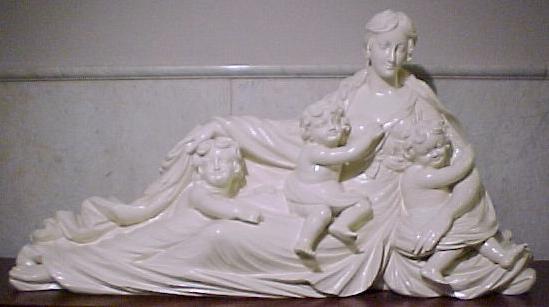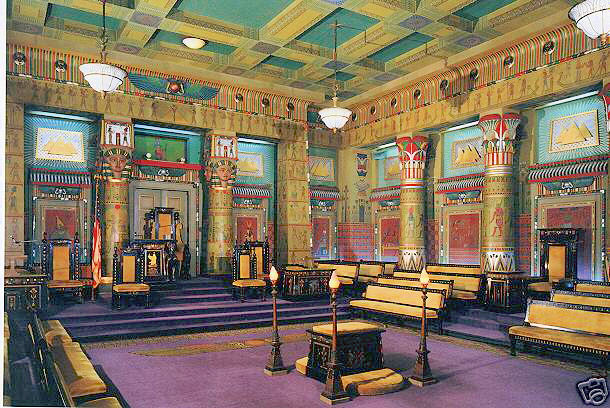|
Statues of
"Faith, Hope & Charity"
at the Grand Lodge
of Pennsylvania in Philadelphia
William Rush is considered
America’s first major sculptor. He began his career as a carver of ship
figureheads in the thriving shipbuilding industry of Philadelphia.
As his reputation grew in figurehead carving, he accepted commissions from
prominent individuals outside the nautical community. After the Masonic Hall on
Chestnut Street burned in 1819, the Building Committee of the Grand Lodge
commissioned William Rush & Son to carve figures for the newly reconstructed
Grand Lodge Hall (used 1820-1835). Seven of his works (the two cherubim, Faith,
Hope, Charity, Silence and Virtue) form the largest collection of Rush’s work in
one place.

Faith - In the theological ladder, the
explanation of which forms a part of the instruction of the First Degree of Masonry, faith
is said to typify the lowest round. Faith, here, is synonymous with confidence
or trust, and hence we find merely a repetition of the lesson which had been
previously taught that the first, the essential qualification of a candidate for
initiation, is that he should trust in God. In the lecture of the same
Degree, it is said that "Faith may be lost in sight; Hope ends in fruition; but
Charity extends beyond the grave, through the boundless realms of eternity."
And this is said, because as faith is "the evidence of things not seen," when we
see we no longer believe by faith but through demonstration; and as hope lives only in the
expectation of possession, it ceases to exist when the object once hoped for is at length
enjoyed, but charity, exercised on earth in acts of mutual kindness and forbearance, is
still found in the world to come, in the sublimer form of mercy from God to his erring
creatures.

Hope - The second round in the theological and
Masonic ladder, and symbolic of a hope in immortality. It is appropriately
placed there, for, having attained the first, or faith in God, we are led by a
belief in His wisdom and goodness to the hope of immortality. This is but
a reasonable expectation; without it, virtue would lose its necessary stimulus and vice
its salutary fear; life would be devoid of joy, and the grave but a scene of
desolation. The ancients represented Hope by a Nymph or maiden holding in her hand a
bouquet of opening flowers, indicative of the coming fruit; but in modern and Masonic
iconology, the science of Craft illustrations and likenesses, it is represented by a
virgin leaning on an anchor, the anchor itself being a symbol of hope.

Charity - "Though I speak with the tongues
of men and angels, and have not charity, I am become as sounding brass, or a
tinkling cymbal. And though I have the gift of prophecy, and understand all
mysteries and all knowledge; and though I have all faith, so that I could remove
mountains, and have not charity, I am nothing" (First Corinthians xiii,
1-2). Such was the language of an eminent apostle of the Christian church, and such
is the sentiment that constitutes the cementing bond of Freemasonry. The apostle, in
comparing it with faith and hope, calls it the greatest of the three, and hence in
Freemasonry it is made the topmost round of its mystic ladder. We must not fall into
the too common error that charity is only that sentiment of commiseration which
leads us to assist the poor with pecuniary donations. Its Masonic, as well as its
Christian application, is more noble and more extensive. The word used by the
apostle is, in the original translation, love, a word denoting that kindly state
of mind which renders a person full of good-will and affectionate regard toward others.
John Wesley expressed his regret that the Greek had not been correctly translated
as love instead of charity, so that the apostolic triad of virtues would
have been, not "faith, hope, and charity," but "faith, hope, and
love." Then would we have understood the comparison made by Saint Paul, when he
said, "Though I bestow all my goods to feed the poor, and though I give my
body to be burned, and have not love, it profiteth me nothing." Guided
by this sentiment, the true Freemason will "suffer long and be kind." He
will be slow to anger and easy to forgive. He will stay his falling Brother by
gentle admonition, and warn him with kindness of approaching danger. He will not
open his ear to the slanderers, and will close his lips against all reproach. His
faults and his follies will be locked in his breast, and the prayer for mercy will ascend
to Jehovah for his Brother's sins. Nor will these sentiments of benevolence be
confined to those who are bound to him by ties of kindred or worldly friendship alone;
but, extending them throughout the globe, he will love and cherish all who sit beneath the
broad canopy of our universal Lodge. For it is the boast of our Institution, that a
Freemason, destitute and worthy, may find in every clime a Brother, and in every land a
home.
The Grand Lodge of Pennsylvania Temple in Philadelphia

The Grand Lodge of
Pennsylvania Museum and Library is located at One North Broad Street,
Philadelphia, PA. For group tours please call (215) 988-1900.

Egyptian Lodge
room at the Grand Lodge of Pennsylvania

To get books related to Freemasonry and the Ancient Mysteries.

|
